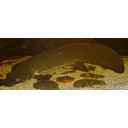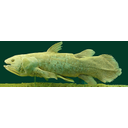Lobe-finned Fishes
Sarcopterygii - lobe-finned fishes
| Vertebrata; Gnathostomata; Osteichthyes; Sarcopterygii |
The Sarcopterygii, or lobe-finned fishes, is a clade containing the coelacanths, lungfishes, tetrapods, and their fossil relatives, including the osteolepiformes and
panderichthyids. They are the sister group to the ray-finned fishes
(Actinopterygii), together forming the bony fishes (Osteichthyes).
Sarcopterygians are
characterised by their fleshy pectoral and pelvic (paired) fins that articulate
with the pectoral (shoulder) and pelvic (hip) girdles via a single bone. This
is apparent in the coelacanths and lungfishes, which are more intuitively
fish-like. These lobe-fins gave rise to the paired limbs of tetrapods, with the
single bones representing the humerus (forelimb) and femur (hindlimb).
The once-diverse
coelacanths (Actinistia) are now represented by just two species in a
single genus -Latimeria chalumnae and L. menadoensis.
The lungfishes (Dipnoi) are also a small relict of a once-diverse assemblage, with
only six extant species in three genera - Protopterus (4x species), Lepidosiren paradoxa, and Neoceratodus forsteri.
The
palaeontological record makes clear that the terrestrial verterbates evolved
from lobe-finned fishes nearly 400 million years ago during the Devonian, and
are therefore members of the Sarcopterygii. The only terrestrial vertebrates
still living today are the tetrapods, which originated around 350 million years
ago and are defined as that group which comprises the common ancestor of the
living amphibians and amniotes plus all its descendants. The vertebrate conquest of the land
was a major evolutionary transition that required many morphological and
physiological changes away from a fish-like form, and has given rise to around
21100 living species and probably many more extinct forms. As such, the extant tetrapods are considered in depth in the following ZooMoodle
webpages.
While some
molecular data have proposed a sister group relationship between lungfishes and
coelacanths to the exclusion of tetrapods (e.g., nuclear 28S rRNA gene; Zardoya
& Meyer 1996), and certain studies have been unable to statistically reject
the placement of the coelacanths as the closest living relative of the
tetrapods (Zardoya & Meyer 1997a, Zardoya et al. 1998), most morphological,
palaeontological, and molecular evidence (e.g., combined mitochondrial protein
coding genes) supports the lungfishes as the closest living relatives to the
tetrapods, to the exclusion of the Actinistia (Meyer & Zardoya, 2003). This
is further supported by a unique deletion in the gene encoding RAG2 that is uniquely
shared between tetrapods and lungfishes (Venkatesh et al. 2001). This
prevailing view is depicted in the following phylogeny:

Distribution and Habitat:
Fossils
of Coelacanths have been discovered on every continent, evidence of their
previous distribution (Helfman et al., 2009). But modern coelacanths have a
limited geographic distribution. Previously thought extinct, Latimeria chalumnae has been indentified since 1938
in the waters of the West Indo Pacific Ocean near the
The Dipnoi have a
wider distribution - Central and South
Africa (Protopterus), Amazon and Paron riverbasins of South America (Lepidosiren), and Queensland, Australia (Neoceratodus) (Bone and Moore, 2005; Helfman
et al. 2009). They inhabit freshwater streams, rivers and swamps. During
drought, Protopterus and Lepidosiren will burrow into the earth, breath
intermittently with their lung and can remain in this state of torpidity for
months to avoid desiccation (Helfman et al, 2009).Neoceratodus is unable to estivate and lives only in deep rivers where
there is no risk of drought.
Conservation Status (IUCN):
Latimeria chalumnae is classified by the
IUCN as critically endangered. Latimeria menadoensis isvulnerable, but there have only ever
been three sighting of this species so it is difficult to ascertain populations
levels (IUCN, 2008). Both species are often by-catch of deep sea trawlers and
shark nets. Low fecundity and slow growth rates put the Coelacanths at risk of
extinction and even small depletions in population size can take decades to
recover.
The Dipnoi are not
considered at risk of extinction because of their wide distribution. But they
do face anthropogenic threats such as habitat loss and degradation - contruction of dams impedes
flooding, the spread of agriculture is reducing wetland habitats and both
practices produce harmful pollution (IUCN, 2008).
Features:
Licensed under the Creative Commons Attribution Non-commercial Share Alike 3.0 License
'Vertebrate Diversity' has been released as an open educational resource (OER) on a Creative Commons 'Attribution Non-commercial Share Alike' license. This means that once downloaded, content can be modified and improved to complement a particular course. This requires, however, that improvements are recycled back into the OER community. All content present at the time of download must be accordingly credited and, in turn, novel content must be appropriately licensed. For more information, please refer to the license deed by clicking on the link above.

